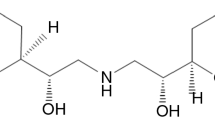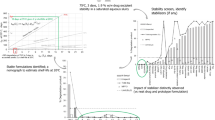Abstract
The E a values of aspirin hydrolysis, as a result of hydroniumion catalysis, intramolecular-nucleophilic catalysis, and hydroxyl-ion catalysis, were significantly different from each other when determined in the 30–40, 45–55, and 60–70°C ranges. The different E a values were attributed to differences in both ΔH* and ΔS*, which could be accounted for by the various activated complexes formed in the hydrolysis of aspirin for each mechanism and the disruptive effect of temperature on the iceberg structures of water present around the phenyl group and the methyl group of aspirin at 42 and 58°C, respectively. A linear relationship observed between the calculated “differential” enthalpy and entropy values, with a slope (compensation temperature) value of about 307° K, supported a role for icebergs associated with hydrophobic groups in the formation of the activated complexes. This study illustrates that the predicted shelf life of a drug at room temperature could be erroneous if estimated from a single E a value which is calculated from the decomposition rate constants determined at widely spaced temperatures in the range of 10–70°C, using the Arrhenius relationship.
Similar content being viewed by others
REFERENCES
G. Nemethy and H. Scheraga. J. Chem. Phys. 36:3382–3400 (1962).
G. Nemethy and H. Scheraga. J. Chem. Phys. 36:3401–3417 (1962).
G. Nemethy and H. Scheraga. J. Phys. Chem. 66:1773–1789 (1962).
J. B. Nagwekar and H. B. Kostenbauder. J. Pharm. Sci. 59:752–757 (1970).
J. B. Nagwekar and N. Muangnoicharoen. J. Pharm. Sci. 62:1439–1444 (1973).
L. J. Edwards. Trans. Faraday Soc. 46:723–735 (1950).
L. J. Edwards. Trans. Faraday Soc. 48:696–699 (1952).
E. Garrett. J. Am. Chem. Soc. 79:3401–3408 (1957).
K. Ogawa and N. Tobe. Bull. Chem. Soc. Jap. 39:227–232 (1966).
A. A. Frost and R. G. Pearson. Kinetics and Mechanism, 2nd ed., John Wiley and Sons, New York, 1961, p. 45.
R. G. Bates. Determination of pH Theory and Practice, John Wiley and Sons, New York, 1964, p. 76.
R. C. Weast and S. M. Selby. CRC Handbook of Chemistry and Physics, 48th ed., Chemical Rubber Co., Cleveland, Ohio, 1967, p. D-92.
K. Laidler. Chemical Kinetics, 2nd ed., McGraw-Hill, New York, 1965.
Minitab Release 5.1.1, 1985, Minitab, Inc., 3081 Enterprise Drive, State College, PA.
A. M. Azzam. Z. Phys. Chem. Neue Folge Bd. 32:S309–S326 (1962).
H. S. Frank. Science 169:635–641 (1970).
D. H. Everett. Discuss. Faraday Soc. 24:220–222 (1957).
R. Lumry and S. Rajender. Biopolymers 9:1125–1227 (1970).
Author information
Authors and Affiliations
Rights and permissions
About this article
Cite this article
Kishore, A.K., Nagwekar, J.B. Influence of Temperature and Hydrophobic Group-Associated Icebergs on the Activation Energy of Drug Decomposition and Its Implication in Drug Shelf-Life Prediction. Pharm Res 7, 730–735 (1990). https://doi.org/10.1023/A:1015867622421
Issue Date:
DOI: https://doi.org/10.1023/A:1015867622421




